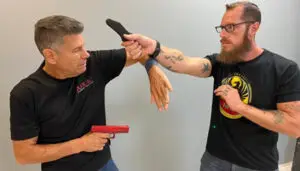As a firearms and use of force instructor, I sometimes have need for blank cartridges (“blanks”) and blank-firing guns, usually for use in simulation training exercises (also called “Reality Based Training” or “RBT”). For example, we used blank-firing revolvers in a recent RBT program I helped run for the armed congregant security team at a local house of worship, and also for an RBT Simunitions FX training class, with role players, at our local police academy’s shoot house. In both cases, the blanks were fired out of sight of the trainees, to create the realistic impression that an active shooter had entered the facility.
First, the instructor must recognize that there are significant dangers involved in using blanks. An insufficiently-trained individual can mistake live rounds for blanks, as in the 2016 fatal training accident in Punta Gorda, Florida. And blanks themselves can sometimes cause deaths or serious injuries. The instructor should get and read IALEFI’s Guidelines for Simulation Training Safety, which has an entire section on safe use of blanks, and how not to use blanks.

Blank-firing revolvers are commonly available for three types of blanks. These are “starter pistols” (used for starting races and other athletic events) that fire: (1) .22 rimfire black powder blanks, like those made by Winchester, (2) crimped .22 rimfire blanks, like those made by CCI, or (3) 209 shotshell primers. Of the three, the crimped blanks make the least noise, the black powder blanks are louder, and the 209 shotshell primers are by far the loudest. The black powder blanks have a feature, of advantage in some settings and a detriment in others, of emitting a small cloud of smoke when each blank is fired. Be sure this won’t set off your smoke detectors if they are fired indoors. Indoor use of any blanks should be done with adequate ventilation, for health reasons.
Although both types of .22 rimfire blanks can be fired in any .22 revolver, the instructor is urged to use starter-type revolvers that will ONLY fire blanks, to avoid any chance of a fatal accident by someone putting live .22 rounds into a functional revolver. Starter pistols have solid barrels with no bore, so they cannot fire a projectile.
Blank-firing revolvers are available over the internet for shipment to most (not all) states, often from dog-training supply companies, for prices ranging from $35 – $45 for crudely-made, cast pot metal guns that may be functional, to top-of-the-line, finely-made blank revolvers from Charter Arms and other makers.
The Charter Arms models retail in the range of $265-$295, and include the Model 82290 that fires .22 rimfire blanks, and the Model 82090 that fires 209 shotshell primers. Both models have solid barrels, so they cannot fire projectiles. They are much easier to load and use, and I believe will probably last longer, than the cheaper starter pistols. They are available either with an orange-anodized aluminum frame, or in all black. I recommend the orange version, as it is harder to confuse with a conventional revolver that fires lethal munitions.
There are also semiautomatic pistols made to fire 8mm blanks. Many models are available, ranging from about $75 to $120. I have not found them to be as reliable as the better blank revolvers. Finally, there are electronic starter pistols, some ranging from $200 to $300. I have not yet used them, so I cannot comment.
I most often use blank revolvers in training simply as noisemakers, not to aim and fire at trainees or actors. If you are going to fire the blank guns toward any person, do so only at a considerable distance, with the person wearing eye protection and other appropriate protective equipment, and without pointing the gun in such a way that, if a live round were fired, it could possibly hit the person. The dangers are obvious. I suggest you relegate blank guns to the “noisemaker only” role, or that you script your scenario so that the blank gun is not fired at people. For example, an actor at the end of a hallway who appears to aim and fire the blank gun at someone who cannot be seen around the corner, followed by screams from around the corner, should be more than sufficient to realistically, but safely, simulate an active shooting in progress. Again, get and read IALEFI’s Guidelines for Simulation Training Safety. No instructor conducting RBT programs should be without it. Contact IALEFI to get your copy today: https://www.ialefi.com/contact/
Emanuel Kapelsohn: IALEFI’s 1st Vice President:
Manny has been an IALEFI Board member for 38 years, a law enforcement firearms instructor for 46 years, and an expert witness on firearms and use of force in state and federal court cases nationwide for over 40 years. He was a Staff Instructor at Col. Jeff Cooper’s American Pistol Institute (“Gunsite”), and was lead instructor for the NRA’s Police Semiautomatic Pistol Instructor Seminars taught at USMC Base Quantico and other locations. He has taught armorer and firearms instructor courses for Glock and other gun makers, has taught use of force to police academy recruits, in the Criminal Justice Department at Indiana University, and for federal agencies, and has been a sworn, armed reserve deputy sheriff for 26 years.


